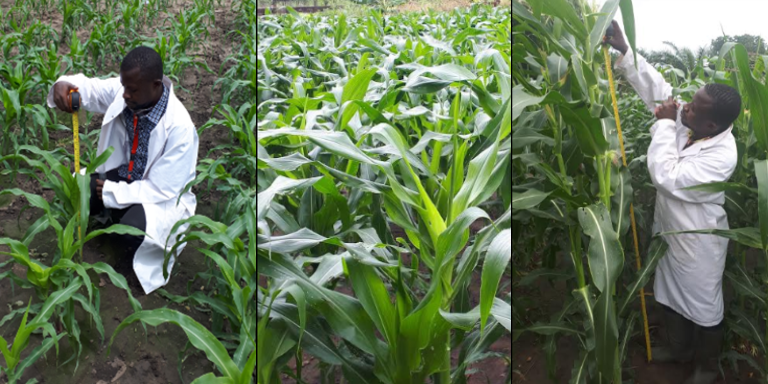Water-saving irrigation: not too wet, not too dry but just right!

RECIRCULATE research is revealing new approaches to water-efficient food production in Ghana and beyond.
The title of Sustainable Development Goal 6 “Clean water and sanitation” makes it easy to think that it is focused just on drinking water and water used in sanitation. But if you look beyond the headline then you see that SDG6 actually has much broader targets. For example, research within the GCRF-funded RECIRCULATE project considers Target 6.3 “….substantially increasing recycling and safe reuse” through the use of anaerobic digestion to treat wastewater. The whole project is committed to target 6.B “Support and strengthen the participation of local communities in improving water and sanitation management”. The key SDG target for my research at the Institute for Industrial Research (CSIR-IIR: part of Ghana’s Council for Scientific and Industrial Research- CSIR) is Target 6.4, which refers to “….substantially increase water-use efficiency across all sectors…..” That target recognizes that the demand for water resources comes not just from direct human use but also from many industrial uses, including agriculture.
The use of water in agriculture has increased substantially over recent decades, and now uses around 70% percent of all fresh water use globally. Looking ahead, efficient use of water resources is imperative to increase crop production to feed a population expected to reach 9 billion by 2050. Yet water is an increasingly restricted asset, not least in the face of climate change. Drought remains a major challenge for food production, not least in many parts of Africa.
Closer to home, one of the significant setbacks in vegetable production in Ghana is the inability of farmers to determine the correct amount of water required by the crop. This usually results in either too little water or over-irrigation, both of which reduce crop growth, yield, and quality. That highlights both a challenge and an opportunity as we think about how can we “….substantially increase water-use efficiency” in crop production. How can we help farmers to use the right amount of water at the right time to meet their crops needs without wasting this precious resource?
At the moment, most farmers in Ghana decide when to irrigate and how much water to apply using their intuitive assessment of whether the soil surface is wet or dry, number of leaves, appearance of flowers or fruit and change in colour of leaves. There is often a temptation to ‘be generous’ but over-irrigation not only wastes water, it can actually damage the crop. So is there a better way to decide when and how much to irrigate? What can we learn from the basic plant biology?
Plants obviously don’t feel thirsty like we do, but they do have systems that detect the water status of their tissues and use a system of hormones to respond accordingly. One key response is the closure of the pores in the leaf surfaces through which water is lost. Closing these pores- ‘stomata’- reduces water loss, but also limits the uptake of carbon dioxide from the air, and that can reduce photosynthesis, growth and, ultimately, yield. From this perspective of basic plant biology, irrigation would ideally maintain the plant between having too much water- when water is used inefficiently- and too little water- when water deficit closes the stomata so much that it limits growth. That’s the theory, but how do we deliver it?
Delivery comes down to what has become known in the irrigation community as ‘deficit irrigation’ but which I like to think of it as “Goldilocks irrigation”. Do you know the old English nursery rhyme about Goldilocks and the Three Bears? Space scientists certainly seem to know it because they talk about the “Goldilocks zone” where a planet is “not too hot, not too cold but just right” for life. If it’s good enough for NASA, then why can’t I adopt it for irrigation? So what we need is to irrigate so that crops are “not too wet, not too dry, but just right”! In fact, pioneering research by our RECIRCULATE colleagues at Lancaster has shown that getting irrigation ‘just right’ does much more that improving the efficient use of irrigation water. It can also improve the yield and quality of crops, protect the quality of water and reduce the water, fertilizer and energy costs.
My RECIRCULATE research focuses on the evaluation and adoption of different irrigation technologies in tomato production in Ghana. If you’ve read the RECIRCULATE blogs by my colleagues at CSIR-CRI, you’ll have come across alternate wetting and drying (AWD) and partial-root zone drying (PRD). Both are approaches to deficit irrigation. PRD allows part of the root system to become dry for certain periods. In Ghana, where many crops are grown on ‘ridge and furrow’ systems, this can be simply changing from always watering both furrows to watering the furrow on one side of the ridge for a period, then swapping to water the other, and so on. AWD allows a crop to ‘dry down’ between watering so that plant closes its stomata ‘just enough’ to save water without compromising yield.
That’s the how of ‘Goldilocks irrigation’ but how do we decide when we need to irrigate so that water is “just right”? That’s exactly what I have been studying in my field trials at CSIR-IIR. I have compared farmer intuition with methods such as thermal imaging, tensiometers and moisture sensors. Over three-four months in the field, our tomato crops typically use 400-600 mm of water with irrigation based on farmer intuition. Using thermal imaging technology we have been able to reduce water use by almost 90% without any any major differences in the crop growth. Our field trials are showing that these changes to irrigation practice can make a real difference to improving efficient use of irrigation water in Ghana. Our work with local farming communities, like that at CSIR Crops Research Institute (CSIR-CRI) is clarifying how we can put these approaches in the hands of those who will use them on the ground. By bringing those two together will help make sure irrigation is “just right” for productive, water-efficient crop production in Africa.
 |
Gilbert Osei is versatile researcher with interest in deficit irrigation, drip irrigation, pitcher irrigation and irrigation water quality. He holds a first degree in General Agriculture and a MPhil degree in Irrigation technology. He is currently working carrying out one of three integrated research projects in RECIRCULATE WP3 – Water for Food Production. He is also a doctoral fellow at the Department of Agricultural Engineering, University of Cape Coast, Ghana pursuing a PhD in Irrigation technology and Management. |
All articles in The FLOW are published under a Creative Commons — Attribution/No derivatives license, for details please read the RECIRCULATE re-publishing guidelines.
